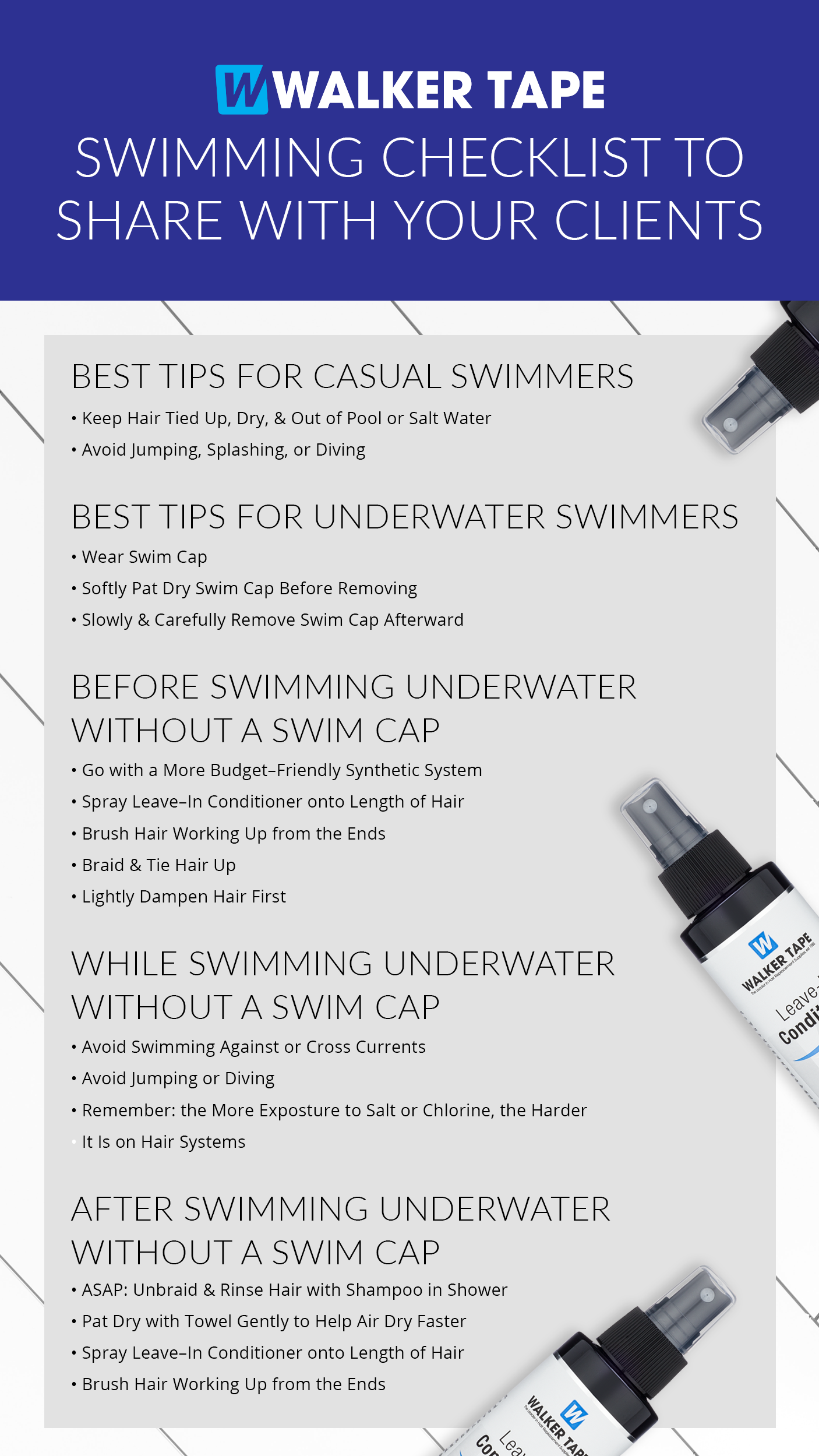
Yes, Walker Tape Products Are Waterproof
Walker Tape liquid adhesives, hard bonds, and tapes are waterproof. So, regardless of your preferred install method, you are working with products with waterproof performance. This is true across our Daily Wear, Extended Wear, and Maximum Wear options. Whether your clients need hair systems to hold for a day or a month, you have various waterproof options to choose from.
There’s a simple, yet thoughtful reason why we’ve created all our tapes and adhesives to be waterproof. Your clients are going to sweat, shower, and get hit with a few raindrops from time to time.
Our waterproof tapes and adhesives allow your clients to be their real selves in the real world living the lifestyle they want to live. If they love to exercise, with Walker Tape, they can get at it. If they love to go for walks in the rain and swingingly sing from lamp posts, Walker Tape supports them in that too.
Give your clients waterproof performance, and apply to be a Walker Tape wholesale customer today!
When your clients ask about waterproof options, they’re often asking about swimming. Since swimming usually involves a lot more than just fresh water to consider, the rest of the blog offers advice you can pass on to your beach-bound clientele.
Waterproof Walker Tape Products & Swimming
Swimming is often short for swimming in chlorinated pools, salty oceans, or bodies of water with currents, rapids, and waves. With all these other challenges, water becomes the gentlest factor involved.
Waterproof does not mean chlorine-proof. It also doesn’t mean salt-proof. Plus, if your clients love the high dives and playing in the waves, then the issue to consider here isn’t so much the water. It becomes the pressure pulling on the hair system.
All tapes and adhesives will be affected by these things. Chlorine, for example, must be harsh enough to disinfect water. Yet, this harshness does a number on hair and skin. Salt naturally draws moisture out of things, and that’s why salt works so well as a preservative. It dries moisture that would otherwise help bacteria and mold grow.
So, salt and chlorine tend to dry out and make hair systems feel brittle and frizzy. With enough repeated exposure, salt and chlorine also can weaken the bonds made by tapes and adhesives.
Then there’s the pressure involved in diving into water or swimming in currents. Underwater pressure pulling on hair systems can cause issues. For these reasons, we have tips to share with your clients.
Following these suggestions helps them have their hair systems and their water fun too!
For Your Casual Swimmer Clients
By casual, we mean those clients preferring to keep everything dry above the neck. They may love to simply soak in hot tubs, hot springs, or cool off comfortably in the water.
For casual swimmers, the advice is straightforward. They should protect their hair system by keeping it tied up and out of the water’s reach. This includes avoiding splashing, jumping, diving, or currents that can turn a casual swimmer suddenly into an underwater swimmer.
For Your Underwater Swimmers
Underwater swimmers have the potential of putting more stress on their systems. But the advice for them here is also simple enough. They should wear a swim cap.
Wearing a swim cap keeps their hair system safely in place and protects it from damage caused by chlorine, salt, and pressure. Once your clients are ready to get out of the water, they should softly pat dry the swim cap so it’s easier to remove. Taking it slowly can help your clients remove caps without accidental slipping or pulling on the hair system underneath.
For Your Underwater Swimmers Without a Swim Cap
Swimming underwater without a swim cap is the scenario with the highest risk involved. That said, some clients for whatever reason may not like or want to wear caps. They also may have forgotten to pack their cap and are reaching out to you seeking last minute help.
While there may be more risk in this situation, there are definitely ways to help safeguard your client’s hair system as much as possible. Below, we take you through what your clients can do before, during, and after swimming underwater without a cap.
Beforehand
Encourage them to use more cost-effective synthetic wigs for the swimming season. Salt, chlorine, and currents add extra wear and tear on a system and shorten the lifespan. Considering this, it might be best for them to go swimming in options a bit more disposable than their favorite systems.
Also, you may want to encourage them during install appointments to go with Max Hold Sport. It’s our strongest scalp protector that helps boost hold times. Max Hold Sport’s added strength can give your clients even more support before they hit the pool.
Remind them to spray in Leave-In Conditioner along the ends and length of their systems. Leave-In Conditioner helps your client work out any tangles before getting in water.
Once they’ve applied Leave-In Conditioner, suggest that they brush out any tangles starting at the ends of the hair. The Leave-In Conditioner and the brushing all prepare them to be able to successfully braid and tie their hair up. Swimming in braids keeps all the fun from leaving your clients with matted or tangled hair afterward.
If your clients have hair systems with hair too short to braid/tie up, then stress again the need for a swim cap. Remind them that Olympic champions wear swim caps.
Right before your client gets in the pool or ocean, suggest that they lightly dampen their hair first with fresh water. This helps saturate the hair follicles with fresh, unchlorinated water. This trick might help avoid the hair from then fully saturating with chlorinated water or salt water while they swim.
During
The principle here is to keep your clients on the lookout. Encourage them to avoid swimming against or across currents or waves that can pull on your hair system. Also, it may be worth reminding them to avoid jumping or diving into water because of the pressure pulling on the hair system.
The last thing to keep them on the lookout for is time. When swimming in pools or the sea, less time is best. The more time your client spends exposing their hair system to chlorine or salt water, the harder it can be on their system.
Afterward
After they get out, stress the need to unbraid and rinse out the “bad” water with fresh shower water and shampoo ASAP. This tip limits the effect of salt and chlorine on their hair.
While air-drying is the gentlest approach, you can suggest they briefly pat dry with a towel to help speed up an air-dry. Once their hair is completely dry, they can add moisture back into their hair systems by spraying in Leave-In Conditioner. All that’s left to do from this point is softly brush from the ends up and look forward to their next fun day in the water!

Have hair extension clients who want to go swimming? Check out our post dedicated to providing you with advice for swimming with hair extensions.




